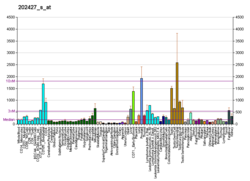Protein-coding gene in the species Homo sapiens
| MPC2 |
|---|
|
| Identifiers |
|---|
| Aliases | MPC2, BRP44, mitochondrial pyruvate carrier 2, SLC54A2 |
|---|
| External IDs | OMIM: 614737; MGI: 1917706; HomoloGene: 31675; GeneCards: MPC2; OMA:MPC2 - orthologs |
|---|
| Gene location (Human) |
|---|
 | | Chr. | Chromosome 1 (human)[1] |
|---|
| | Band | 1q24.2 | Start | 167,916,675 bp[1] |
|---|
| End | 167,937,072 bp[1] |
|---|
|
| Gene location (Mouse) |
|---|
 | | Chr. | Chromosome 1 (mouse)[2] |
|---|
| | Band | 1|1 H2.3 | Start | 165,288,206 bp[2] |
|---|
| End | 165,308,783 bp[2] |
|---|
|
| RNA expression pattern |
|---|
| Bgee | | Human | Mouse (ortholog) |
|---|
| Top expressed in | - sperm
- thoracic diaphragm
- left testis
- right testis
- right ventricle
- renal medulla
- mucosa of sigmoid colon
- Skeletal muscle tissue of rectus abdominis
- myocardium of left ventricle
- liver
|
| | Top expressed in | - cardiac muscle tissue of left ventricle
- masseter muscle
- interventricular septum
- atrioventricular valve
- seminiferous tubule
- extensor digitorum longus muscle
- digastric muscle
- right kidney
- tunica adventitia of aorta
- thoracic diaphragm
|
| | More reference expression data |
|
|---|
| BioGPS |  | | More reference expression data |
|
|---|
|
| Gene ontology |
|---|
| Molecular function | - pyruvate transmembrane transporter activity
| | Cellular component | - integral component of membrane
- mitochondrial inner membrane
- membrane
- mitochondrion
- nucleus
- integral component of mitochondrial inner membrane
| | Biological process | - mitochondrial acetyl-CoA biosynthetic process from pyruvate
- positive regulation of insulin secretion involved in cellular response to glucose stimulus
- mitochondrial pyruvate transmembrane transport
- transport
| | Sources:Amigo / QuickGO |
|
| Orthologs |
|---|
| Species | Human | Mouse |
|---|
| Entrez | | |
|---|
| Ensembl | | |
|---|
| UniProt | | |
|---|
| RefSeq (mRNA) | | |
|---|
| RefSeq (protein) | | |
|---|
| Location (UCSC) | Chr 1: 167.92 – 167.94 Mb | Chr 1: 165.29 – 165.31 Mb |
|---|
| PubMed search | [3] | [4] |
|---|
|
| Wikidata |
| View/Edit Human | View/Edit Mouse |
|
Mitochondrial pyruvate carrier 2 (MPC2) also known as brain protein 44 (BRP44) is a protein that in humans is encoded by the MPC2 gene.[5][6][7] It is a member of the Mitochondrial Pyruvate Carrier (MPC) protein family.[8] This protein is involved in transport of pyruvate across the inner membrane of mitochondria in preparation for the pyruvate dehydrogenase reaction.[9]
Interactive pathway map
Click on genes, proteins and metabolites below to link to respective articles.[§ 1]
[[File:
|alt=Glycolysis and Gluconeogenesis edit]]
Glycolysis and Gluconeogenesis edit
- ^ The interactive pathway map can be edited at WikiPathways: "GlycolysisGluconeogenesis_WP534".
Clinical significance
Mutations in the MPC2 gene cause an autosomal recessive disease comparable to the symptoms of Mitochondrial pyruvate carrier deficiency (MPC1 gene).[10] The symptoms associated with mutations in the MPC2 gene include early-onset neurological problems, normal lactate/pyruvate ratio (however both lactate and pyruvate are in higher than normal concentrations), lactic acidosis, hypotonia, cardiomegaly, and facial dysmorphia.[10]
See also
References
- ^ a b c GRCh38: Ensembl release 89: ENSG00000143158 – Ensembl, May 2017
- ^ a b c GRCm38: Ensembl release 89: ENSMUSG00000026568 – Ensembl, May 2017
- ^ "Human PubMed Reference:". National Center for Biotechnology Information, U.S. National Library of Medicine.
- ^ "Mouse PubMed Reference:". National Center for Biotechnology Information, U.S. National Library of Medicine.
- ^ Wiemann S, Weil B, Wellenreuther R, Gassenhuber J, Glassl S, Ansorge W, et al. (March 2001). "Toward a catalog of human genes and proteins: sequencing and analysis of 500 novel complete protein coding human cDNAs". Genome Research. 11 (3): 422–435. doi:10.1101/gr.GR1547R. PMC 311072. PMID 11230166.
- ^ Tsou AP, Lai C, Danielson P, Noonan DJ, Sutcliffe JG (March 1986). "Structural characterization of a heterogeneous family of rat brain mRNAs". Molecular and Cellular Biology. 6 (3): 768–778. doi:10.1128/mcb.6.3.768. PMC 367577. PMID 3022128.
- ^ "BRP44 brain protein 44". Entrez Gene.
- ^ "mitochondrial pyruvate carrier (MPC) (TC 2.A.105) family". UniProt.
- ^ "Pyruvate transmembrane transporter activity". QuickGO. EMBL-EBI.
- ^ a b Pujol C, Lebigot E, Gaignard P, Galai S, Kraoua I, Bault JP, et al. (March 2023). "MPC2 variants disrupt mitochondrial pyruvate metabolism and cause an early-onset mitochondriopathy". Brain. 146 (3): 858–864. doi:10.1093/brain/awac444. PMC 9976959. PMID 36417180.
Further reading
- Hartley JL, Temple GF, Brasch MA (November 2000). "DNA cloning using in vitro site-specific recombination". Genome Research. 10 (11): 1788–1795. doi:10.1101/gr.143000. PMC 310948. PMID 11076863.
- Simpson JC, Wellenreuther R, Poustka A, Pepperkok R, Wiemann S (September 2000). "Systematic subcellular localization of novel proteins identified by large-scale cDNA sequencing". EMBO Reports. 1 (3): 287–292. doi:10.1093/embo-reports/kvd058. PMC 1083732. PMID 11256614.
- Wiemann S, Arlt D, Huber W, Wellenreuther R, Schleeger S, Mehrle A, et al. (October 2004). "From ORFeome to biology: a functional genomics pipeline". Genome Research. 14 (10B): 2136–2144. doi:10.1101/gr.2576704. PMC 528930. PMID 15489336.
- Mehrle A, Rosenfelder H, Schupp I, del Val C, Arlt D, Hahne F, et al. (January 2006). "The LIFEdb database in 2006". Nucleic Acids Research. 34 (Database issue): D415–D418. doi:10.1093/nar/gkj139. PMC 1347501. PMID 16381901.



















